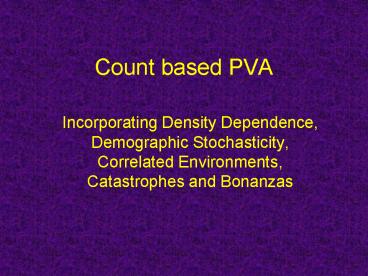Count based PVA - PowerPoint PPT Presentation
1 / 36
Title:
Count based PVA
Description:
Explicitly include Alee effects in the population model. Nt 1 = Nt2. A Nt. ? r- Nt. The parameters ... Alee effects generated by mate-finding problems ... – PowerPoint PPT presentation
Number of Views:104
Avg rating:3.0/5.0
Title: Count based PVA
1
Count based PVA
- Incorporating Density Dependence, Demographic
Stochasticity, Correlated Environments,
Catastrophes and Bonanzas
2
Assumptions of the diffusion appoximation
- Population growth
- Is unaffected by population density
- Its only source of variability is environmental
stochasticity - No trends in its mean and the variance
- Its values are not correlated in successive years
- Moderate variability
- No observation error
3
But..
- Incorporating these effects into PVA models
require - more and better data
- more mathematically complex models
4
Negative density dependence
- The simplest way to incorporate negative density
dependence is introduce a population ceiling to
the density-independent population growth model
?tNt if Nt lt K
Nt1
K if Nt gt K
5
The ceiling model
Program algo2 (prepared by Matt 10,50,.55,.45,60)
6
Mean time to extinction
Where cµ/s2, dlog(Nc/Nx), and klog(K/Nx)
If NcK and Nx 1 then
7
Extinction risk predicted by the Ceiling Model
µ 0.1
Program tbarpedro
µ 0.001
µ -0.1
s2 µ
s2 2µ
s2 4µ
s2 8µ
8
The theta logistic model
- A gradually changing growth rate
9
(No Transcript)
10
The theta logistic model
11
(No Transcript)
12
The Bay checkerspot butterflyEuphydryas editha
bayensis
front
Harrison et al., 1991 JRC population
13
The negative association remains after removing
the outlier in the right
back
14
Density Dependent model
- Find the best model Fit three models to the data
using nonlinear least-squares regression of
log(Nt1/Nt) against Nt - Models to be tested
- Density independent model log(Nt1/Nt)r
- The Ricker model
log(Nt1/Nt)r(1-Nt/K) - The theta logistic model
log(Nt1/Nt)r1-(Nt/K)T
15
Estimate the parameters of each model
16
Model maximum likelihood of a model assuming
normally distributed deviations is
- ln(Lmax) -(q/2)ln(2?Vr) 1)
- Vr residual variance
- q Sample number
17
Maximum log likelihood
- The probability of obtaining the observed data
given a particular set of parameter values for a
particular model - Information criterion statistics combine the
maximum log likelihood for a model with the
number of parameters it include to provide a
measure of support
18
Support is higher for
- models with higher likelihoods, and
- models with fewer parameters
- More complex models are penalized because more
parameters will always lead to a better fit to
the data, but at the cost of less precision in
the estimate of each parameter and incorporation
of spurious patterns from the data into future
populations
19
Akaike Information Criteria
- To identify the best model
- AICc -2 ln(Lmax ) (2pq)/ (q-p-1)
- p Number of estimated parameters (including the
residual variance) - q sampling number
20
Akaike weights
exp-0.5(AICc,i-AICc,best)
Wi
? exp-0.5(AICc,i-AICbest)
21
Compute the maximum log likelihood and Akaike
weights for each model
22
Simulate the model to predict population
viability
qVr
s2
q-1
Program extprobpedro
Program theta_logistic
23
Simulate the model to predict population
viability
Program extprobpedro
Program theta_denindeppedro
24
Allee effects
- We can simply set the quasi-extinction threshold
at or above the population size at which Alee
effects become important - Explicitly include Alee effects in the population
model
Nt2
? r-ßNt
Nt1
ANt
25
The parameters
maximum
Value at A
The potential offspring
Fraction of potential reproduction that is
actually achieved
26
A discrete-time model with Alee effects
generated by mate-finding problems
27
A discrete-time model with Alee effects
generated by mate-finding problems
28
Combined effects of Demographic Environmental
stochasticity
29
Combined effects of Demographic and Environmental
stochasticity
r0.1,K15, T1, b.1
r0.1,K15, T1, b1.5
30
Correlation of deviations
31
Environmental correlation
- When the environmental effects on the population
growth rate are correlated, the effective
environmental variance in the log population
growth rate is (Foley 1994) - (1?)/(1-?)s2
32
(1?)/(1-?)s2
Variance without correlation
33
Generate the correlated environmental variation
- ? ? ?t-1 vs2v (1-?2)zt
- ? correlation coefficient
- zt random number drawn from a normal
distribution with mean 0 and variance 1 - ?t-1 is the sum of a term due to correlation
with the previous environment deviation and a new
random term, scaled by a factor to assure that
the long string of ? is s2
34
Extinction risk and correlation
r0.8
r1.4
Nt1
Nt
Nt
35
r0.8
r1.4
36
Catastrophes and Bonanzas






























